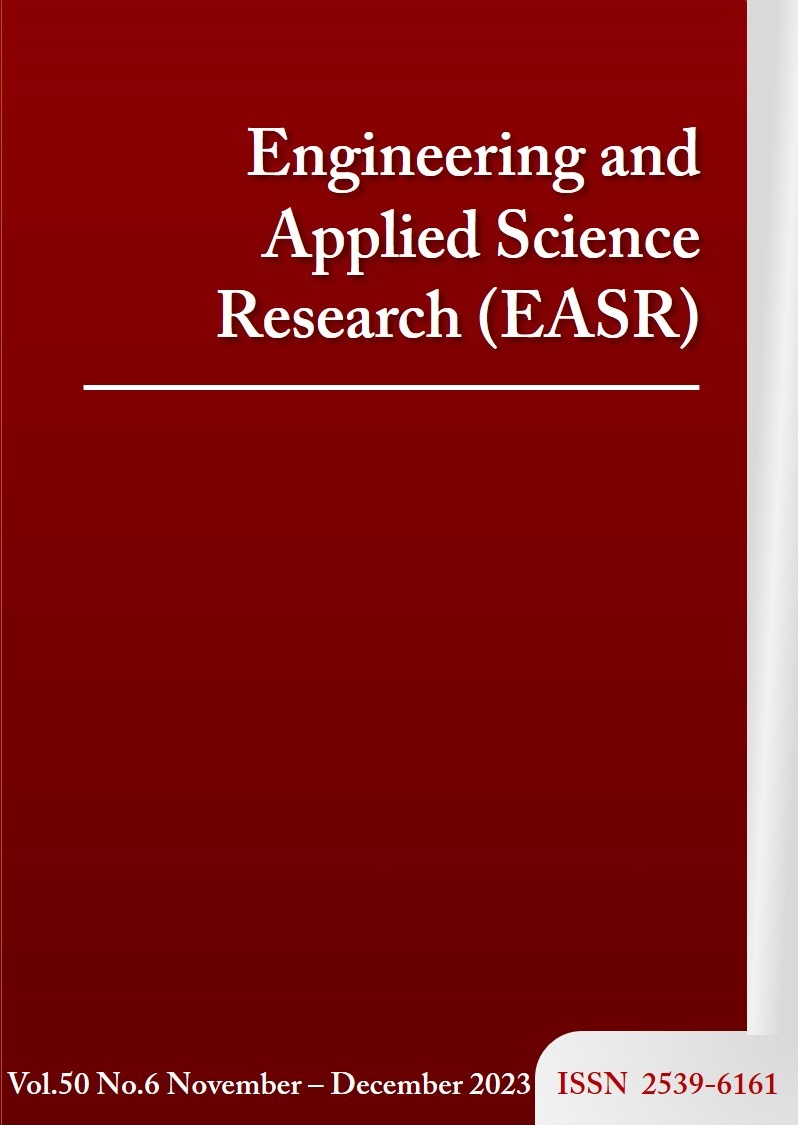Cocoon waste reinforced in epoxy matrix composite: Investigation on tensile properties and surface morphology
Main Article Content
Abstract
There is potential for using silkworm cocoon waste such as broken, damaged, discarded and uncoiled cocoons as well as the caterpillars that remain inside. Cocoon waste is estimated to account for up to 11% of raw cocoon input in the textile industry. The aim of the present work is to use cocoon waste as the natural fiber reinforcement in an epoxy resin matrix composite. Cocoon waste with different weight fractions of 0 wt%, 25 wt%, 42 wt%, 58 wt%, and 75 wt% were used as reinforcement with an epoxy resin matrix to fabricate the composite material by hand lay-up technique. Subsequently, tensile testing and scanning electron microscopy observations were employed to evaluate the performance of the proposed composite materials. Experimental results demonstrated that the tensile strength continuously increased as cocoon waste fiber increased from 25 wt% to 58 wt%, reaching a maximum tensile strength of 61.04 MPa. Elastic modulus showed a slight difference of 25 wt% to 58 wt%, a maximum of 762.91 MPa. However, at 75 wt%, the tensile strength and elastic modulus declined by 57.07 MPa and 515.69 MPa, respectively. The 58 wt% of cocoon waste was presented as the optimum ratio for reinforcement with an epoxy resin matrix. The SEM image revealed the dispersion of cocoon waste in an epoxy resin matrix, presenting the close-packed interfacial bonding between cocoon waste fiber and matrix. This research is useful for the development of cocoon waste-based composites with improved mechanical properties.
Article Details

This work is licensed under a Creative Commons Attribution-NonCommercial-NoDerivatives 4.0 International License.
This work is licensed under a Creative Commons Attribution-NonCommercial-NoDerivatives 4.0 International License.
References
Sanjay MR, Siengchin S, Parameswaranpillai J, Jawaid M, Pruncu CI, Khan A. A comprehensive review of techniques for natural fibers as reinforcement in composites: preparation, processing and characterization. Carbohydr Polym. 2019;207:108-21.
Karimah A, Ridho MR, Munawar SS, Adi DS, Ismadi, Damayanti R, et al. A review on natural fibers for development of eco-friendly bio-composite: characteristics, and utilizations. J Mater Res Technol. 2021;13:2442-58.
Pickering KL, Efendy MGA, Le TM. A review of recent developments in natural fibre composites and their mechanical performance. Compos Part A Appl Sci Manuf. 2016;83:98-112.
Helaili S, Chafra M, Chevalier Y. Natural fiber alfa/epoxy randomly reinforced composite mechanical properties identification. Structures. 2021;34:542-9.
Zhao HP, Feng XQ, Yu SW, Cui WZ, Zou FZ. Mechanical properties of silkworm cocoons. Polymer. 2005;46(21):9192-201.
Ranakoti L, Gangil B, Rajesh PK, Singh T, Sharma S, Li C, et al. Effect of surface treatment and fiber loading on the physical, mechanical, sliding wear, and morphological characteristics of tasar silk fiber waste-epoxy composites for multifaceted biomedical and engineering applications: fabrication and characterizations. J Mater Res Technol. 2022;19:2863-76.
Chen S, Cheng L, Huang H, Zou F, Zhao HP. Fabrication and properties of poly(butylene succinate) biocomposites reinforced by waste silkworm silk fabric. Compos Part A Appl Sci Manuf. 2017;95:125-31.
Xu Z, Wu M, Gao W, Bai H. A transparent, skin‐inspired composite film with outstanding tear resistance based on flat silk cocoon. Adv. Mater. 2020;32(34):1-8.
Sashina ES, Yakovleva OI. The current state and prospects of recycling silk industry waste into nonwoven materials. Fibers. 2023;11(6):56.
Sericulture Department, Ministry of Agriculture and Cooperatives. Survey results of sericulture income by province, year 2020 [Inthernet]. 2021 [cited 2023 Aug 9]. Available from: https://qsds.go.th/qsisplan/wp-content/uploads/sites/119/2021/06/Silk-mulberry-income-2020.pdf.
Shah DU, Porter D, Vollrath F. Can silk become an effective reinforcing fibre? A property comparison with flax and glass reinforced composites. Compos Sci Technol. 2014;101:173-83.
Sealy C. Silk shows new strengths in composites. Reinf Plast. 2015;59(6):294-301.
de Oliveira CG, Margem FM, Monteiro SN, Lopes FPD. Comparison between tensile behavior of epoxy and polyester matrix composites reinforced with eucalyptus fibers. J Mater Res Technol. 2017;6(4):406-10.
Chen F, Porter D, Vollrath F. Structure and physical properties of silkworm cocoons. J R Soc Interface. 2012;9(74):2299-308.
Babu KA, Krishna SVG, Subrahmanyam BV, Ali MDA. Mechanical properties of slag reinforced polymer composites. IJMPERD. 2013;3(4):69-74.
Zhang J, Kaur J, Rajkhowa R, Li JL, Liu XY, Wang XG. Mechanical properties and structure of silkworm cocoons: a comparative study of Bombyx mori, Antheraea assamensis, Antheraea pernyi and Antheraea mylitta silkworm cocoons. Mater Sci Eng C. 2013;33(6):3206-13.
Cocco A, Masin SC. The law of elasticity. Psicológica. 2010;31:647-57.
Lee SM, Cho D, Park WH, Lee SG, Han SO, Drzal LT. Novel silk/poly(butylene succinate) biocomposites: the effect of short fibre content on their mechanical and thermal properties. Compos Sci Technol. 2005;65(3-4):647-57.
Han SO, Lee SM, Park WH, Cho D. Mechanical and thermal properties of waste silk fiber-reinforced poly(butylene succinate) biocomposites. J Appl Polym Sci. 2006;100(6):4972-80.
Priya SP, Ramakrishna HV, Rai KS. Utilization of waste silk fabric as reinforcement in epoxy phenol cashew nut shell liquid toughened epoxy resin: studies on mechanical properties. J Compos Mater. 2006;40(14):1301-11.
Anidha S, Latha N, Muthukkumar M. Reinforcement of Aramid fiber with bagasse epoxy bio-degradable composite: investigations on mechanical properties and surface morphology. J Mater Res Technol. 2019;8(3):3198-212.
Ho M, Wang H, Lau K, Lee J, Hui D. Interfacial bonding and degumming effects on silk fibre/polymer biocomposites. Compos Part B Eng. 2012;43(7):2801-12.



